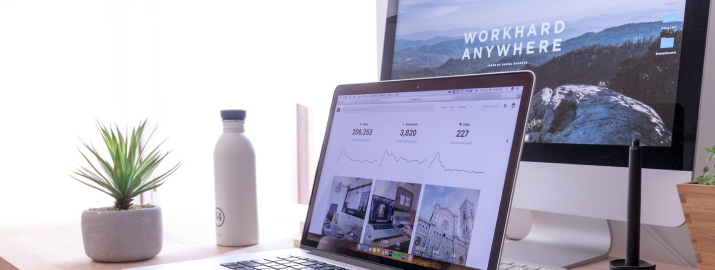
Creativity and Remote Work: What Do They Have in Common?
Table of Contents
It feels good to work from home, but at times it may feel like remote work kills creativity. There are days when the flow is interrupted constantly by the audiophile neighboor or the attention-seeking pet by your side.
All of this can bring your effectiveness down, especially if you work in a creative field like illustrating, writing, composing, or anything as such. For many professionals, it’s a disaster to deal with so many distractions.
The secret to getting the most out of the creative part of your brain while working remotely is small daily rituals. Through those, you can keep ideas fresh and your productivity up high.
1. Create a Comfortable Work Environment
Here, the concept of comfort is very broad. It ranges from buying an ergonomic chair to arranging your own workspace. And it even involves the clothes you wear during work hours!
What we mean is: you need a place that favors and flourishes your focus.
For example, at the beginning of the pandemic, many people migrated to remote work without exactly having an appropriate space to work from at home. In these cases, creativity was really compromised.
However, to be creative, the ideal is to have an exclusive space to work. It doesn’t have to be a separate room just to be used as your office, a tidy desk is enough. The important thing is that you turn the switch whenever you are in this space.
It should be all yours: with the decoration you like, with a little space for your pet, with space for your laptoop, agenda, and everything else you will use.
Music sometimes helps to wake up the creativity monsters. According to Ricardo Luis Von Groll, Content Manager of Talentify, when he lacks inspiration, there is nothing better than a mug of coffee and some great music to get us going! By this way, you can better focus on the creative process, regardless of your area of expertise. And, additionally, you can still easily relax in the other rooms of your house without connotating them with work.
2. Take Breaks and Don’t Overload
Working around the clock, getting notifications all the time, and replying to messages outside of working hours undermine creativity. And what’s worse, they harm your mental health.At first, you may not mind doing all this. But in the long run, it becomes difficult to create stuff and to bring about solutions.
It is especially more delicate for those who work remotely from their own home: over time, you find it difficult to enjoy your home!
That’s because when you’re overloaded, you’re in the kitchen making a sandwich and then you remember a report. Or are you in the living room choosing which series to watch and you remember that email from Frank the accountant…
So don’t be afraid to take small breaks during the day. When we used to work from the office, this moment was that break to exchange ideas in the kitchen over coffee or in the printer room.
Now, it could be a 15 minute break playing with the dog, watering the plants, talking to your mom, or just doing a simple stretch and making sure you have good posture.
This rest for the brain contributes to your health and creativity. It’s the kind of creative leisure – which, despite the name, has nothing to do with laziness, but with rest between workdays to clear your head.
SEO copywriter, Mary Zhou from Zen Media shared some insights about breaking the creative block. She’s using her body to sustain her flow whenever she has a creative block has been quite beneficial. It’s her technique of reminding herself that thoughts exist outside of her head. “Working remotely allows me to take a stroll whenever I need it to recharge my “creative rejuvenation”, she said.

3. Change the Routine
One of the main advantages of being remote is working your way. So enjoy!
Talk to your leaders and, as much as possible, make small changes in your routine whenever you feel that your ideas are blocked.
And if you are a team leader, be flexible to these changes as often as possible.
Some transformations are simple to do, while others require more planning.
Here are some examples:
- Work in another room in the house;
- Take the notebook to the backyard;
- Set a fixed day to work at a cafe or at the mall;
- Spend a week working from the coast or inland;
- Have a happy hour with the team (through a video conference);
- Wear a different outfit a few days a week;
- Work at different times every once in a while;
- If you have friends who are also remote workers, visit them and work from their habitat;
- Take a day off when possible.
These are just some ideas. The important thing is not to fall into an inspiring routine.All-in-all the most important part is self-knowledge: you can discover that your routine is the best in the world. Or maybe you realize that the ocean breeze was the missing ingredient to get your creative juices flowing.
4. Create Personal Projects
This was already valid in the face-to-face days of work, but now it’s easier to execute. After all, with the time and energy you save in traffic, you can do a lot of cool stuff, right?
For example:
- Write a diary;
Learn to create web pages; - Launch your blog;
- Write a movie script;
- Learn one new recipe a week;
- Photographing pets;
- Create an Instagram account to post book reviews;
- Paint pictures with watercolor.
Seriously, it can be anything as long as it stimulates your intellect and gives you pleasure. Even if it has nothing to do with your area of expertise.
But if you want to take advantage of the after-hours to improve skills, you can too. Whether with online courses or with small personal projects.
If you’re a programmer, making an app for an NGO you believe in is a great way to keep your brain sharp. Or if you work with digital marketing, create email marketing campaigns for your aunt’s small pastry business.

